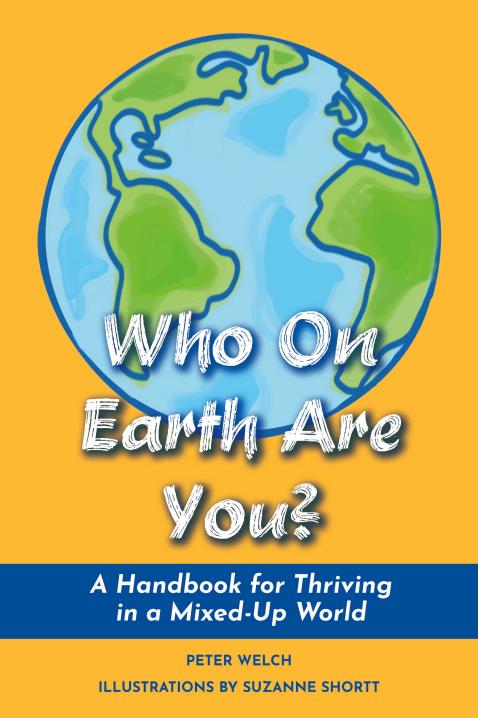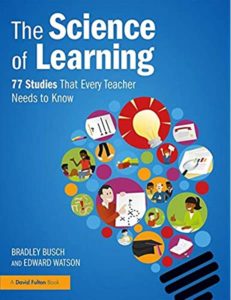
When I started in this field, back in 2008, teachers really didn’t have many helpful books to draw on.
Books about teaching? Sure. Books about psychology and neuroscience research? Absolutely. Books bringing those topics together? Not so much…
What a difference a decade makes!
These days, we’ve got so many books that it’s hard to keep up. My “Read This Now” pile has been growing for months. Only in the last few weeks — since I sent my own book to the publisher — have I had time to read again.
I want to share a few recent discoveries with you.
Generative Learning in Action
A new series of books, edited by Tom Sherrington, focuses on research “in Action.” They’re all quite short — less than 100 pages — and carefully focused on practical classroom applications of research.
Sherrington kicked off this series with Rosenshine’s Principles in Action last year. Now, Zoe and Mark Enser’s book explores Fiorella and Mayer’s theory of Generative Learning.
Unlike many such books, this one focuses more on what students are doing. Specifically, generative learning invites them to do mental work that makes sense of their learning.
The Ensers describe eight distinct kinds of generative learning. Some — like “summarizing” — seem straightforward, even mundane. Others — like “drawing” or “enacting” — might feel more daunting to some students.
In every case, Generative Learning explains how these activities require their big three mental activities: selecting, organizing, and integrating information. When students “map” a topic, for instance, they have to select relevant ideas, organize them into meaningful patterns, and integrate them into a coherent whole.
The Ensers take care care to offer specific classroom examples of these eight strategies. Several chapters include “case studies” from other teachers who have put them to use.
They also emphasize the limitations that might make them less helpful. (Researchers call these “boundary conditions.”) For instance, almost all of these techniques require some working memory headroom. They also benefit from a fair amount of explanation and practice.
One important caveat. As noted above, generative learning strategies focus on the cognitive work that students do. The Ensers explicitly emphasize that such generative learning does not replace teaching but follows teaching. That is: we don’t use these strategies so that students might figure out concepts on their own. We use them so that students might consolidate ideas they learn in class.
In brief: this book — which takes less than an hour to read — provides clear explanations and practical examples. If you want both new ideas to try and new ways to think about your students’ classroom work, give Generative Learning a read. (Next up in the series: Ollie Lovell explores Cognitive Load Theory.)
The Science of Learning: 77 Studies that Every Teacher Needs to Know
In our work, you’ll often hear that we teachers should try a certain technique because “research says so.”
“What research?” we ask. “Well — you know — the research,” comes the reply.
In this usefully skimmable book, Bradley Busch and Edward Watson (no relation, that I know of) briskly summarize 77 research studies that might usefully guide our practice.
For each study, they describe its design, its main findings, and its classroom applications.
Should we really spread practice out over time? Check out #4. (BTW, I’ll give you a hint. “Yes.”)
How do we make feedback more effective? #25 has some answers.
What does PISA data tell us about helping disadvantaged students? The answers — summarized in #62 — might surprise you.
In this book, Busch and Watson provide lots of useful information. AND, they offer insights into reading and understanding research studies.
The more of these recaps you read, the more insight you’ll have into the strategies researchers use to answer the questions that they ask. (However: don’t be fooled by the repeated tagline “the one about” — as in, “the one about reading out loud.” ALL psychology research requires MANY studies.)
Like Generative Learning, The Science of Learning makes for a helpful, easy, and informative read.
Who On Earth Are You
Given the importance of cross-cultural understanding, it would be great to find a wise guide for negotiating its inherent difficulties.
How do different cultures think about time? About hierarchy? About uncertainty?
How do those differences influence teaching, learning, and schoolkeeping?
In his new book — Who On Earth Are You?: A Handbook for Thriving in a Mixed-Up World — Peter Welch brings several perspectives to these complex questions. (The illustrations are by his wife, Suzanne Shortt.)
Clearly, Welch knows A LOT of research. For instance, he explores Richard Lewis’s theory about cultural modes of communication: linear-active, multi-active, and reactive.
Despite his scholarly knowledge, Welch keeps his book light and personal.
Having lived in many countries and many continents, he has humorous and sad and enlightening stories to tell.
Having taught in schools — and run schools — from Africa to Turkey to Singapore to Finland to Thailand, he particularly understands how cultural differences shape educational expectations and experiences.
Welch has more than the usual share of “I thought it would turn out this way, but gosh was I wrong!” stories to illustrate the questions he explores. (For instance: the production of Romeo and Juliet he staged in Lesotho included — to his great surprise — lots of spontaneous audience participation.)
If you teach — or plan to teach — in a school with a rich cultural blend, Welch’s humility, humor, and insight offer new ways to think about living and teaching in our “mixed-up world.” He makes a thoughtful and encouraging guide on this adventure.







